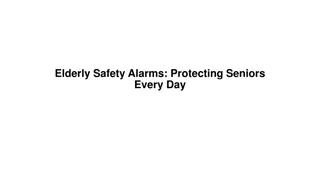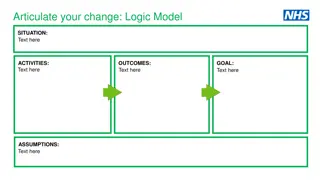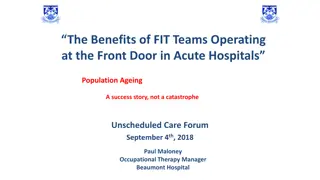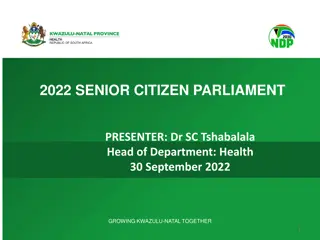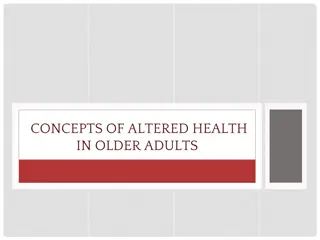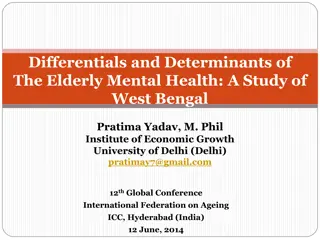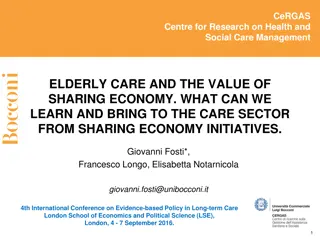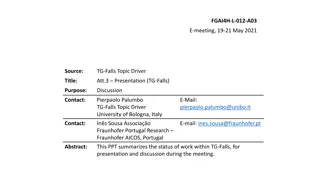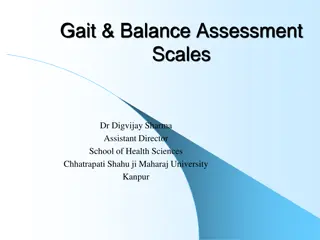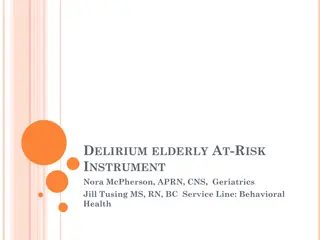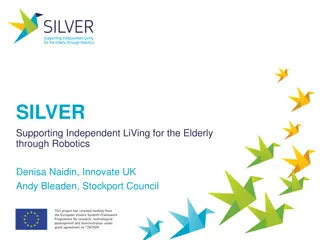Understanding the Health and Challenges of the Elderly Population
Explore the health, demographics, and classification of the elderly population, including global life expectancy trends and specific details about the elderly population in KSA. Gain insights into the challenges faced by the elderly and the importance of elderly care in society.
Download Presentation

Please find below an Image/Link to download the presentation.
The content on the website is provided AS IS for your information and personal use only. It may not be sold, licensed, or shared on other websites without obtaining consent from the author. Download presentation by click this link. If you encounter any issues during the download, it is possible that the publisher has removed the file from their server.
E N D
Presentation Transcript
HEALTH OF THE ELDERLY POPULATION
LEARNING OBJECTIVES Define and classify the elderly population Explain the demographic changes associated with ageing of the population List the health and social problems associated with ageing Describe the interaction between physical ill-health, social problems, psychological problems and functional limitations State the top ten causes of years lived with disability, disability adjusted life years lost and death among elderly 70+ years in KSA Outline the aims and aspect of elderly care
DEFINITION OF ELDERLY POPULATION The United Nations has not adopted a standard criterion but use the age of 60 years and above to refer to older or elderly population The CDC uses the age of 65 years and above to refer to elderly population The starting age defining the elderly population matches the age of pension that varies between countries (60 years or 65 years)
CLASSIFICATION OF ELDERLY POPULATION Classified into Young old (60 to less than 75 years) 1. Old (75 years to less than 85 years) 2. Oldest old (85 years and above) 3. Frail elderly (above 60 years with cognitive impairment or a disability) 4.
GLOBAL LIFE EXPECTANCY AT BIRTH Life expectancy at birth (in years) 90 80 77 80 72 70 66 70 60 50 40 30 20 10 0 1990 2000 2006 2025 2050 About 1.2 billion people over the age of 60 expected to be in 2025 and this number will raise to reach 2 billion by 2050; 70% will be living in low and middle income countries. Source: US Bureau of census
Per 1000 35 28 30 29 25 POPULATION GROWTH, KSA 30 25 20 22 17 19 15 13 10 4 4 4 5 3 0 1995 2005 2015 2025 CDR (per 1000 population) CBR (per 1000 population) Population growth (per 1000 population) Source: Ministry of Economy and Planning, Central Department of Statistics and Information
Years 78.0 LIFE EXPECTANCY AT BIRTH, KSA 77.0 77.0 76.0 75.0 75.0 74.0 73.0 73.0 72.0 71.0 71.0 70.0 69.0 68.0 1995 2005 2014 2025 Source:Ministry of Economy and Planning, Central Department of Statistics and Information
POPULATION PYRAMID, KSA Population = 21,311,904 Population = 18,755,041 Source:Ministry of Economy and Planning, Central Department of Statistics and Information
POPULATION PYRAMID, KSA - 2014 Population = 27,345,986 Source:Ministry of Economy and Planning, Central Department of Statistics and Information
POPULATION PYRAMID, KSA - PROJECTION Population = 33,825,413 Population = 40,250,628 Source:Ministry of Economy and Planning, Central Department of Statistics and Information
Percentage & number of the elderly (60+ years), KSA Percent of total population Number of Elderly 20.0 8000000 17.9 18.0 7000000 16.0 7,219,905 6000000 14.0 5000000 12.0 9.0 10.0 4000000 8.0 3000000 5.0 3,039,078 6.0 3.8 3.8 2000000 4.0 1000000 1,368,294 2.0 712,302 816,341 0.0 0 1995 2000 2014 2030 2050 Percent of total population Number of elderly Source:Ministry of Economy and Planning, Central Department of Statistics and Information
Percentage of the elderly & children below 15 years, KSA Elderly (% of total population) < 15 years (% of total population) 20.0 45.0 41.0 17.9 18.0 40.0 37.7 16.0 35.0 14.0 27.6 30.0 12.0 23.0 25.0 10.0 20.0 19.1 8.0 9.0 15.0 6.0 10.0 4.0 5.0 5.0 3.8 3.8 2.0 0.0 0.0 1995 2000 2014 2030 2050 Elderly (%of total population) < 15 years (%of total population) Source:Ministry of Economy and Planning, Central Department of Statistics and Information
GLOBL CHALLENGES FACING THE INCREASE IN THE ELDERLY POPULATION Strains on the social security systems; Demands for health care and social services; Needs for trained-health workforce in gerontology; Needs for long-term care, particularly for dementia; and Counteract pervasive ageism that denies older people the rights and opportunities available for other adults.
HEALTH OF THE ELDERLY POPULATION
Increase longevity is associated with an increase in: EFFECTS OF AGEING 10 years 60 years 80 years Chronic & degenerative diseases Functional disability Chronic disease Functional disability Depression Depression Increase dependency and the need for medical and social care
PROBLEMS OF THE ELDERLY PHYSICAL PROBLEMS MENTAL PROBLEMS SOCIALPROBLEMS Chronic/degenerative diseases Low social contact Cognitive impairment : Nutrition problems Low social involvement (Dementia) Impairment of special senses Decrease income Psychological problems: Unintentional injuries Unsuitable living conditions (Depression) Deterioration of functional abilities Polypharmacy
HEALTH PROBLEMS AMONG THE ELDERLY Physical and mental health problems among the elderly are characterized by Insidious onset Multitude of ailments Rapid deterioration
CHRONIC AND DEGENERATIVE DISEASES Prevalent chronic and degenerative diseases are Some of these diseases are present in late adult life Hypertension Diabetes Their presence leads to the occurrence of others as complications Heart diseases Stroke (with or without residue) Joint problems (arthritis) Malignancies End result is rapid deterioration in health, increase dependency and low quality of life Incontinence and urgency Prostatic hyperplasia
NUTRITION PROBLEM Primary malnutrition: Reduced intake due to social or economic reasons Secondary malnutrition: Excess loss and reduced absorption Overweight and obesity: imbalance between intake and expenditure of energy
POLYPHARMACY Polypharmacy is defined as taken more than 5 drugs at a time including Prescribed medications Over the counter medications Herbal treatment Polypharmacy is the result of Presence of multitude of diseases Physician s aim to control physical problems Polypharmacy may have adverse health effects on the elderly in the form of side effects and drug interaction.
IMPAIRED SPECIAL SENSES Vision impairment Increase dependence on others Cataract Psychological problems (frustration of not hearing others) Corneal opacity Macular degeneration Social isolation Hearing impairment Increase rate of unintentional injuries Deterioration of smell
UNINTENTIONAL INJURIES Fractures Mostly falls in the elderly own home Being bed bound Slow recovery Unable to regain their status Less likely falls outside the home Increase dependency
INSTRUMENTAL ACTIVITIES OF DAILY LIVING Reflects the abilities of the elderly to live independently It includes Housekeeping Shopping Cooking Use of transportation Use of telephone Dealing with money Taking medications
ACTIVITIES OF DAILY LIVING Reflects the abilities of the elderly for self-care It includes Bathing Dressing Grooming (take care of appearance) Feeding Continence (control urine and stool) Ambulating (moving about) Transfer (moving from one place to another inside the house)
DEPRESSION Commonest psychological disorder among the elderly Insidious onset and progressive course Often not recognized by the elderly or the caregivers Manifested by executive dysfunction
DEPRESSION Physical illhealth Physical dysfunction Social problems Depression More social isolation More physical dysfunction
Top 10 causes of Years Lived With Disability (YLD) among elderly 70+years, KSA http://vizhub.healthdata.org/irank/arrow.php
Top 10 causes of Disability Adjusted Life-Years Lost (DALY) among elderly 70+years, KSA http://vizhub.healthdata.org/irank/arrow.php
Top 10 causes of death among elderly 70+years, KSA http://vizhub.healthdata.org/irank/arrow.php
CARE FOR THE ELDERLY The aim of the elderly care is Promote healthy ageing; growing old and delaying ill-health Provide a comprehensive care at the PHC for early detection and treatment of physical and mental health problems Provide a social support to ensure a decent and safe living Establish long and short term community based services to provide care for the elderly and alleviate tension on the family
PROMOTE HEALTHY AGEING Promoting healthy ageing has its roots in adopting a healthy life style through the lifespan including Maintaining acceptable level of physical activity Adherence to a healthy diet Avoid the use of any tobacco products Avoid the use of alcohol
EARLY DETECTION AND MANAGEMENT Comprehensive health assessment of the elderly at PHC to screen for major health problems through History Medical problems Unintentional injuries Medications Use of standardized tools for the screening for Nutrition problems Hearing impairment Incontinence Functional abilities Depression Dementia
SOCIAL EVALUATION AND SUPPORT Social contact (living in a family, presence of caregiver, frequency of contact with caregiver, nature of relation with caregiver) Social activities (having a profession, friends, hobbies, special interest, outing and extent of satisfaction with social activities) Living conditions (comfort and safety in the house and extent of satisfaction with living conditions) Economic status (tangible wealth, monthly income, extent of coverage of needs)
COMMUNITY-BASED SERVICES Elderly day care centers: Elderly clubs to maintain social interaction Elderly day health centers: Day hospitals for elderly who need nursing care Home services: Provide social and nursing services to elderly in their own homes Residential or institutional care Elderly homes (long term care for elderly who can t live independently in their own homes) Nursing homes (long term care for elderly with health problems requiring continuous medical and nursing care)



